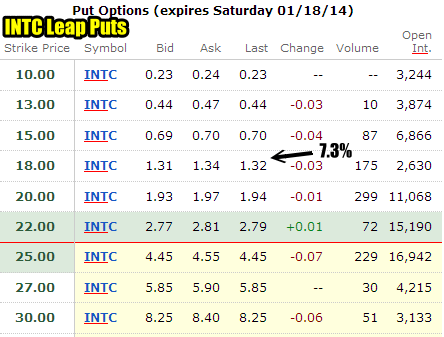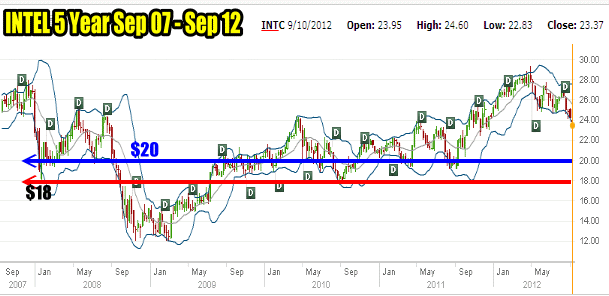Recently I received a question from an investor wondering about Put Selling leaps options on Intel Stock. Let’s review the Intel Stock question: Would you consider selling a LEAP in INTC Stock Jan 2014, Strike $18? I realize you do not like to sell LEAPS OPTIONS, however, you do sometimes – JNJ Stock for example. Just a thought ..
Thank you for the question on Put Selling Leaps Options. The selling of leaps options usually comes down to your goal. With Intel Stock now in a pullback after their earnings warning the Intel Stock Leaps Puts are certainly tempting. If your goal is to own shares but would prefer to wait until next year then I see nothing wrong with the Jan 2014 $18 put strike.The return on the January 2014 leap put is 7.3%. If this return for 16 months is adequate for you then perhaps Put Selling the January 2004 Intel Stock $18 Leaps Options is a good investment.
The chart below shows the Intel Stock January 2014 leaps puts premiums at the close of trading on September 14 2012.

The January 2014 leap puts premiums for INTC Stock
But personally I believe there are better strategies which are simple to implement and can boost that Put Selling return significantly.
Boost The Intel Stock Put Selling Return
I realize that you are probably risk adverse to a degree since you picked the January 2014 Leaps Options put at the $18 put strike on Intel Stock, but consider for a moment the 5 year chart on Intel Stock below. The $18 Intel Stock price is low for the stock when looking out 5 years. During the bear market collapse in 2008 to 2009 the stock fell far below $18.00.
Consider September 2007 For The Same Trade
Let’s pretend instead of it being September 2012, it was instead September 2007 and with Intel Stock trading around $25.00 you decided to sell the Jan 2009 $18 put strike. In September 2007, it seemed like a very good bet that Intel Stock would be higher than $18. At $18 that would be a 28% collapse in the stock. So you feel pretty comfortable and proceed with Put Selling the $18 strike.
On January 16 2009 Intel Stock closed at $13.74, a full 45% collapse in value from the September 2007 price of $25 and 23% decline from your put strike of $18.00. How are you going to feel about the stock with those kinds of losses. Would you still be holding it? Most investors would have dumped their puts and taken a beating to buy them back and get out. Fear is an incredible thing when stocks plunge.
It took until July 2009 for the stock to recover to $18.00. I have investor friends who have invested for a couple of decades and even they dumped their Intel Stock positions in the fall of 2008 taking large losses. Fear is truly something to behold when it comes to investing in risky assets. It is important then, to consider that selling Leaps Options at what seems to be very low valuations is still no guarantee that the stock will not trade below your strike sold. 16 months is a long time in the stock market and a lot can happen. In 2007 selling at the Intel Stock $18 put strike 16 months out probably would have seemed pretty safe. So remember, there is no such thing as a safe bet when it comes to equities.
Back To September 2012
Today the January 2014 $18 put strike will earn you $1.32 which would effectively reduce your cost basis in the stock to $16.68 which is a decent valuation. However when you look at the Intel Stock chart below, the $20.00 valuation is like a razor through the core of Intel Stock over the past 5 years. Even in 2011 Intel Stock traded in the $20.00 value various times.
Since this is a Leaps Options Put Selling trade, would $20.00 not be a better strike to consider?

Intel Stock 5 Year Stock Chart Sep 2007 to Sep 2012
So instead if I consider put selling the Intel Stock January 2014 $20 strike, I would then use margin in this leap put trade for selling far out of the money strikes to increase my return.
First Intel Stock Put Selling Strategy
I could boost my return significantly by using margin to sell puts at out of the money put strikes in the months leading up to January 2014. If Intel Stock closes above the $18 strike naked puts in January 2014 I will have made more than selling just the January 2014 $18 put strike and waiting out the next 16 months.
For example: Let’s take an investment of $20,000.00 (no commissions taken into account in either strategy presented – trade at your own risk. These are ideas only)
Sell 10 put contracts of the January 2014 $20.00 put strike for $2.00 (I would put in an offer at $2.00 and wait for it to get filled – On Friday some traded at $1.98)
Total income = $2000.00
Use 70% of the total value for margin = $20000 X 70 % = $14000 + $2000 in capital from sold puts + $1400 in additional margin from the $2000 in capital.
Total amount of additional capital you can use for more Put Selling = $17400.00
Take the $17400 and consider Put Selling into December 2012 which is 3 months out. Stay below your January 2014 price of $20.00. – Sell the December $19 put strike on a further pullback in Intel Stock and aim for .20 cents. This past week several times the December $19 Intel Stock put traded for .20 cents. Consider 4 put contracts for .20 cents to earn $80 before commissions.
Wait for further pullbacks and consider moving into January 2013 at $17.50 for .18 cents. Sell another 4 put contracts to earn $72.00 before commissions.
Total capital including margin in use on these additional puts = $19 X 400 = $7600.00 $17.50 X 400 = $7000 – TOTAL = $14600.00 (well below your margin amount available)
Consider Commission Costs
The number of contracts and strikes should take into account commission costs. If you are with a cheaper broker such as Interactive Brokers, then selling two groups of 4 put contracts makes sense. If your commissions are higher than you may want to consider selling 8 put contracts and not doing the second set into January 2013.
Watch Margin In Use – Stay Below Available Margin
Watch your margin amount in use and stay below your margin amount available. Your brokerage account should show the total amount of margin available. Don’t be fooled by the totals of margin shown in most brokerage accounts. As you sell more puts your margin amount may not decrease by the amount you expect. This is because every time your sell puts your margin amount takes into account the value of the shares you have sold and calculates back a percentage available for margin. Do not abuse your margin amount. If Intel Stock falls below your put strikes your margin amount may decrease and you may get sold out of some positions without your knowledge. Instead stay below the original margin amount available which will greatly reduce the risk of a margin call in any market downturn.
In my simple example above based on $20,000 investment an investor over the course of a year who repeats the Put Selling cycles successfully could earn an additional $700 to $800. This would increase the return to perhaps $2800 or 14% rather than 10%, a full 40% increase in return.
Cost basis if assigned in January 2014 would be $20,000 less $2800 = $17200 or $17.20.
Second Intel Stock Put Selling Strategy
If you like the above Put Selling Intel Stock concept but think it is too much work or you are unsure of Put Selling against Intel Stock declines, then consider using margin and stay with the leaps options throughout the entire trade.
In your question you indicated selling the Intel Stock January 2014 $18 naked put which would have earned $1.32 before commissions on Friday.
Taking the same concept as the first Intel Stock Put Selling strategy above, take instead an investment of $18,000 and sell 10 of the January 2014 $18 put strikes for $1.32.
Return is 7.3%.
Then use the earned capital of $1320.00 and add in margin available which should create a capital available base of about $14,850.00.
Sell 10 naked puts of the Intel Stock January 2014 $13 put strike which on Friday would have earned .44 cents or $440.00. This would use just $13000 of your additional available capital and significantly reduces the chance of a margin call. By selling the $13 put for $440 you have earned $1760 in total. The original $18 naked puts are covered by your own capital of $18,000. The $13000 for the $13 naked puts is actually using just $11240.00 of capital.
Total return is now $1320.00 plus $440 = $1760 / $18000 = 9.7% and your cost basis in the stock is reduced to $16.24. Therefore if Intel Stock is below $18 but above $13 in January 2014, and you accepted assignment on the January 2014 $18.00 naked puts, your cost basis at $16.24 is decent for selling covered calls.
Worst Case Scenario On Intel Stock
If you were assigned on both the $13 and $18 put strikes your total amount invested would be $13000 + $18000 = $31,000 less $1760.00 = $29,240.00 / 2000 shares = $14.62.
At $14.62 you are sitting pretty low in Intel Stock and should have lots of opportunity for covered calls to work your position toward being exercised.
Commissions On Second Strategy
A big advantage to this second strategy is the lack of commission charges. This could very well end up being just two transactions over the 16 months where the first strategy would have additional commission charges throughout the 16 months.
Chance Of A Margin Call
Even if you only had $18,000 plus the $1760.00 and the rest was all margin, the chance of a margin call is slight. If Intel Stock fell to $12.00 your stock portfolio would be worth $24,000.00. You have a total of $19760.00 tied to this trade and so you are in effect using margin to cover the balance which is $24,000 less $19760.00 = $4240.00. The margin amount available at $12 would be about $16800. You would not face any margin call and in fact could go back to Put Selling at even lower strikes still using margin.
A Word About Margin
In my examples above the margin percentage I have used is 70%, which is on the low side. On a stock like Intel Stock the margin percentage would be higher. However stocks vary in the quality which different brokerages consider. For example, speculative stocks or juniors can have margin rates as low of 40%.
The greatest thing about margin when it comes to Put Selling is that you do not pay any interest when Put Selling against the margin available. You only pay interest when you are put the shares and do not have enough of your own capital available to pay for those shares. Then you are using margin to secure some of the shares. That margin would then contain interest charges. However many investors will sell part of their shares to bring their margin requirements back to zero. Often it is not necessary to sell all of a position out to cover margin needs. If however your brokerage handles a margin call without your knowledge (and many do not have to give you notice in advance), they will normally sell an entire position out depending on how the original trade was executed.
An Example Of Margin Use Gone Bad
Here is a good margin call example. In 1987 the market crashed 25% in one day. I was heavily margined but had left what I though was enough room for a market plunge of 10%, but not enough for a 25% drop in one day. I was at work when my broker (no discounters back then) called about a half hour after the market had opened and advised that they needed an additional $175,000 in cash or they would have to start selling stocks. I told him to sell all my cash instruments as needed. Two hours later he called to say they needed another $25,000 to cover margin as my portfolio was down 30% and ALL of the naked puts I had sold to that point were deep in the money and margin was changing constantly as it was based on the put strikes sold, less the prevailing selling valuations. My broker when he called was in a panic. I can still remember the fear in his voice. He told me that some puts I had sold for $1.00 were trading for $7.00. His voice trembled on the phone. I told him to sell all my Government of Canada 5 year bonds and told him which stocks I wanted to buy. I told him not to buy to close any naked puts. He was stunned and cautioned me that this could be a huge mistake.
This is a typical event which can happen to any investor who uses margin. Today most discount brokerages do not have to advise their clients of a margin call. It is the investors responsibility, so make sure you read your brokerage account terms and conditions before using margin.
Intel Stock Put Selling Leaps Options Summary
The two strategies above are just simple Put Selling strategies. I have written these up in very simple fashion to get you thinking about possible ways to boost the return on a 16 month investment. Remember that you trade at your own risk and you should not blindly implement what you have read but instead you should develop your own goal and objective and put in place a strategy that you are comfortable with. Sleeping nights is important when it comes to investing. Remember too that this bull market which started in March 2009 is now three and a half years old. Most bull markets last 4 to 5 years before a setback occurs. Put Selling Leaps Options into January 2014 could be placing your trade near the end of this bull market. No one will know when this bull market will end.
There are lots of other potential strategies that can be added or changed to the Intel Stock Leaps Options. Option strategies that could be applied to this Intel Stock Put Selling trade are endless. The purpose of this article is to suggest that you could take a very simple strategy and expand on it to increase your return while being aware of risk of assignment.
16 months is a long wait for a trade and most investors tend to tinker with their trades. If you are that type of investor, then consider something along the lines of the first strategy wich includes a bit of trading here and there throughout the 16 months.
If you are the type of investor that can sit back and wait it out and wide fluctuations don’t concern you, then consider something like the second strategy. Remember that if Intel Stock recovers it will take some time before the sold leaps puts lose most of their value. That is the nature of selling that far out in time, but when there is less than 3 months remaining, and if Intel Stock has recovered back above $24, then the leaps puts at $13 and $18 will have lost a lot of value.
Hope this article gets you thinking about options possibilities and how you could use Leaps Options for Put Selling possibilities for all stocks, not just Intel Stock.

